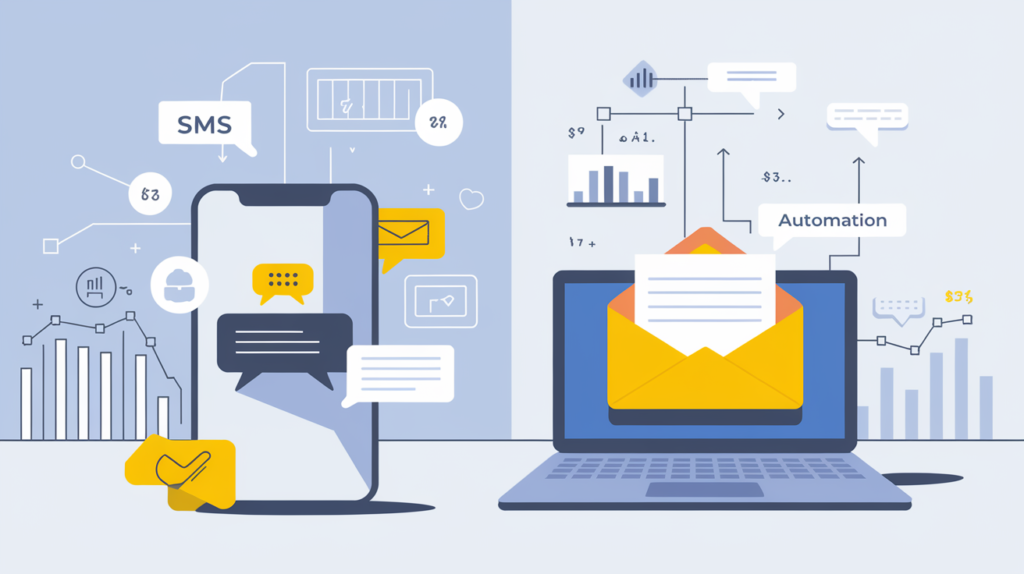SMS or Email? Here’s the Quick Answer:
SMS is best for urgent, short messages with a 98% open rate and fast response times. Email works for detailed content and has a higher ROI – $36 for every $1 spent. The choice depends on your goals: speed and immediacy (SMS) or long-term engagement (Email).
Key Differences:
- SMS: 98% open rate, 36% click-through rate, faster response (90 seconds).
- Email: $36 ROI per $1 spent, better for newsletters, detailed campaigns.
Quick Comparison Table:
| Metric | SMS Marketing | Email Marketing |
|---|---|---|
| Open Rate | 98% | 20.9% |
| Response Time | 90 seconds | 90 minutes |
| ROI | $5:$1 | $36:$1 |
| Click-Through Rate | 36% | 3.2% |
| Message Length | 160 characters | Unlimited |
| Cost | Higher per message | Lower per message |
Pro Tip: Combine both! Use SMS for urgent updates and Email for detailed content to maximize engagement.
Email vs. SMS Marketing in 2025: Which One Wins?
Engagement Metrics Comparison
Here’s how SMS and email marketing stack up when it comes to key engagement metrics.
Open Rate Data
SMS messages boast an average open rate of 98%, far surpassing email’s 20.9% average [5]. The difference is striking and highlights SMS’s ability to grab attention effectively.
| Metric | SMS Marketing | Email Marketing |
|---|---|---|
| Average Open Rate | 98% | 20.9% |
| Time to Open | 90 seconds | 90 minutes |
SMS messages are typically opened within 90 seconds, while emails take an average of 90 minutes. This speed gives SMS a clear edge in driving immediate engagement.
Click-Through Performance
When it comes to click-through rates (CTR), SMS also leads the way with a 36% CTR, compared to email’s 3.2% [6]. The concise and direct nature of SMS, combined with its visibility on mobile devices, minimizes distractions and boosts interaction.
Response Speed Analysis
SMS isn’t just opened faster – it prompts quicker responses too. Nearly 98% of SMS messages are opened within 90 seconds, and 81% are read within five minutes [7]. The response rate for SMS campaigns is an impressive 45%, compared to just 6% for email. Even more compelling, 77% of SMS responses occur within 10 minutes [7].
This rapid engagement makes SMS a go-to choice for time-sensitive campaigns like flash sales, urgent updates, and limited-time offers. Its immediacy ensures your message gets seen – and acted on – when it matters most.
Cost and ROI Analysis
Setup and Operating Costs
Email marketing is a budget-friendly option with relatively low upfront costs. For instance, platforms like GoHighLevel charge an average of $0.675 per 1,000 emails sent [9].
SMS marketing, on the other hand, usually involves higher setup expenses. This includes costs for dedicated phone numbers and ensuring compliance with regulations. Here’s a breakdown of GoHighLevel’s SMS pricing for the U.S. and Canada:
| Message Type (US/Canada) | Cost per Segment |
|---|---|
| Outbound SMS | $0.0079 |
| Inbound SMS | $0.0079 |
| Outbound MMS | $0.0200 |
| Inbound MMS (Local) | $0.0100 |
| Inbound MMS (Toll-free) | $0.0200 |
While SMS offers faster engagement, these higher setup costs mean businesses need to plan their budgets carefully.
Message Cost Comparison
When scaling up, the cost gap between email and SMS becomes even more apparent. In the U.S., SMS messages generally cost between $0.01 and $0.05 per message, while international rates can jump to $0.25 to $0.50 [8]. For example, sending a single SMS campaign to 10,000 subscribers could cost anywhere from $100 to $500, whereas an email campaign to the same audience might cost under $7.
Return on Investment Data
Both email and SMS marketing deliver strong returns, but their strengths differ:
| Marketing Channel | ROI | Average Conversion Rate |
|---|---|---|
| Email Marketing | $42:$1 | 15.2% |
| SMS Marketing | $5:$1 | 29.0% |
Email marketing achieves its ROI through low costs and its ability to build long-term customer relationships. SMS marketing, with a 29% conversion rate compared to email’s 15.2% [3], excels in campaigns that require quick action, like flash sales or cart abandonment recovery.
To get the most out of both channels, it’s smart to combine their strengths. For example, SMS works well for urgent updates and time-sensitive offers, while email is ideal for newsletters and detailed product launches. Platforms like GoHighLevel’s Agency Pro plan, priced at $497/month, simplify this process by integrating both SMS and email, eliminating the hassle of switching between tools.
Understanding these cost dynamics is key to optimizing your marketing strategy, paving the way for a deeper dive into audience targeting options.
sbb-itb-1c6633a
Audience Targeting Options
Audience Segmentation Tools
SMS and email platforms in GoHighLevel CRM offer powerful ways to segment your audience, each tailored for different strategies. Email marketing shines when creating detailed customer groups using multiple data points, while SMS is perfect for quick, behavior-triggered messages.
GoHighLevel’s Agency Pro plan includes advanced tools to segment audiences based on:
| Segmentation Criteria | SMS Use Case | Email Use Case |
|---|---|---|
| Purchase History | Flash sale alerts | Personalized product suggestions |
| Geographic Location | Local store promotions | Regional updates |
| Customer Lifecycle | Appointment reminders | Welcome or onboarding emails |
| Engagement Level | Win-back campaigns | Loyalty program updates |
| Browse Behavior | Cart reminder texts | Product showcase emails |
This kind of segmentation allows for highly tailored and relevant messaging.
Message Personalization Options
Personalized marketing can drive 40% more revenue [10]. Both SMS and email offer unique ways to customize messages based on user behavior and preferences.
SMS personalization focuses on direct, time-sensitive communication, such as:
- “Hi [First Name], your appointment is tomorrow at 2 PM.”
- “Your nearest store in [City] is offering 30% off today!”
- “The item in your cart is almost sold out – grab it now!”
Email personalization allows for deeper customization with features like dynamic content blocks, tailored product suggestions, and automated sequences based on user activity. Teams using personalized email campaigns often see a 53% increase in customer engagement [10]. Triggered emails, in particular, boast a 152% higher open rate compared to traditional email campaigns [11].
When integrated with a CRM, personalization becomes even more effective, ensuring every message feels relevant and timely.
CRM System Integration
GoHighLevel’s integration capabilities make it easy to align SMS and email campaigns. Through its unified dashboard, businesses can:
- Track customer interactions across both SMS and email.
- Automate multi-channel marketing workflows.
- Synchronize customer data in real time.
- Analyze campaign performance metrics.
With 80% of U.S. adults keeping their smartphones within reach during the day [12], combining SMS and email is key for better engagement. GoHighLevel’s Agency Pro plan supports this integration with:
- Automated workflows
- Mobile app functionality
- Advanced analytics
- Multi-channel campaign management
For instance, you can send a time-sensitive SMS – boasting an open rate of up to 98% [12] – followed by a detailed email, ensuring your message fully reaches and engages your audience.
Implementation Guide
SMS Marketing Applications
SMS marketing is perfect for campaigns that need quick action. GoHighLevel’s Agency Pro plan makes running effective SMS campaigns straightforward:
| Scenario | Implementation Strategy | Expected Outcome |
|---|---|---|
| Flash Sales | Send concise 160-character messages with clear CTAs | 35% average click-through rate [13] |
| Appointment Reminders | Schedule automated texts 24 hours before | 90% read rate within 3 minutes [14] |
| Inventory Alerts | Trigger messages when stock hits thresholds | 134% higher response rate vs. email [13] |
| Customer Service | Enable two-way messaging for support | Under 90-second average response time [2] |
“The engagement rates with SMS are really high so we know that it works really well for campaigns like short term flash sales and it’ll obviously work great on Black Friday. If I’ve got the CEO at my desk asking for a few more sales, I know that an SMS will drive that.” – Paul Bonner, Group CRM Director, THG [14]
Now, let’s look at how email marketing complements these instant communication benefits.
Email Marketing Applications
While SMS is great for immediate engagement, email shines in building long-term relationships. Together, they create a strong marketing combo. With GoHighLevel, you can enhance your email campaigns with:
Educational Content:
- Newsletters
- Tutorials
- Updates
- Technical communications
Visual Marketing:
- Product catalogs
- Portfolio showcases
- Brand storytelling
- Seasonal campaigns
Multi-Channel Strategy
Combining SMS and email allows you to make the most of their strengths. SMS grabs attention quickly, while email provides the space for detailed messaging. Integrating these channels can amplify your marketing efforts through:
Channel Integration:
- Use SMS for urgent updates and email for in-depth content.
- Automate sequences to keep both channels in sync.
- Cross-promote between SMS and email to expand your audience.
- Monitor performance on both platforms to refine your strategy.
According to Twilio’s State of Customer Engagement Report 2022, “Businesses (98%) and consumers (83%) agree that personalization increases brand loyalty” [14].
Conclusion
Main Points Summary
The data showcases the unique strengths of each channel. SMS marketing boasts an impressive 98% open rate, with most messages read within three minutes. On the other hand, email marketing offers a $36 return for every $1 spent, compared to SMS’s $5 return [4].
Here’s a quick comparison of key metrics:
| Metric | SMS Marketing | Email Marketing |
|---|---|---|
| Open Rate | 98% | 21% |
| Click-Through Rate | 6–19% | 1.7% |
| Conversion Rate | 29% | 16.72% |
| Deliverability | 97% | 84% |
| Message Cost | $0.01–$0.05 | $0.10–$0.30 |
Channel-Specific Recommendations
- SMS: Best for flash sales, urgent updates, appointment reminders, and campaigns aimed at younger audiences [1].
- Email: Ideal for building long-term relationships, sharing detailed product information, sending newsletters, running complex promotions, and engaging professional audiences.
These strategies help tailor campaigns to the strengths of each channel.
Marketing Communication Updates
Integrated marketing is now the standard, with SMS usage jumping from 55% to 86% between 2022 and 2023 [4].
Emerging trends include:
- AI Integration: Delivering more personalized experiences across platforms.
- Advanced Analytics: Tools like GoHighLevel enable unified tracking for better insights.
- Cross-Channel Automation: A significant 85% of SMS subscribers also opt into email [16].
- Mobile-First Design: Ensuring seamless optimization across devices.
Subscribers who receive both SMS and email are 2.4 times more likely to make a purchase than those receiving SMS alone [15]. Incorporating these insights can help refine your marketing approach for better results.


